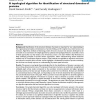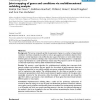BMCBI
2007
14 years 20 days ago
2007
Background: Recognition of binding sites in proteins is a direct computational approach to the characterization of proteins in terms of biological and biochemical function. Residu...
BMCBI
2007
14 years 20 days ago
2007
Background: With the popularisation of high-throughput techniques, the need for procedures that help in the biological interpretation of results has increased enormously. Recently...
BMCBI
2007
14 years 20 days ago
2007
Background: Natural antisense transcripts (NATs) are endogenous RNA molecules that exhibit partial or complete complementarity to other RNAs, and that may contribute to the regula...
BMCBI
2007
14 years 20 days ago
2007
Background: This paper presents a unified framework for finding differentially expressed genes (DEGs) from the microarray data. The proposed framework has three interrelated modul...
BMCBI
2007
14 years 20 days ago
2007
Background: Accurate identification of novel, functional noncoding (nc) RNA features in genome sequence has proven more difficult than for exons. Current algorithms identify and s...
BMCBI
2007
14 years 20 days ago
2007
Background: Identification of the structural domains of proteins is important for our understanding of the organizational principles and mechanisms of protein folding, and for ins...
BMCBI
2007
14 years 20 days ago
2007
Background: Microarray compendia profile the expression of genes in a number of experimental conditions. Such data compendia are useful not only to group genes and conditions base...
BMCBI
2007
14 years 20 days ago
2007
Background: Gene expression is governed by complex networks, and differences in expression patterns between distinct biological conditions may therefore be complex and multivariat...
BMCBI
2007
14 years 20 days ago
2007
Background: Numerous functional genomics approaches have been developed to study the model organism yeast, Saccharomyces cerevisiae, with the aim of systematically understanding t...



